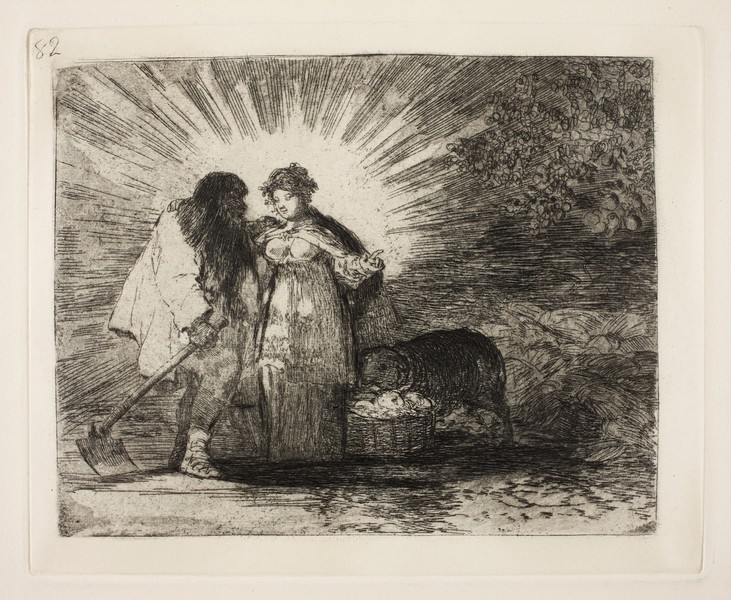- Cronología
- Ca. 1820 - 1823
- Dimensiones
- 174 x 216 mm
- Técnica y soporte
- Aguafuerte, aguatinta, punta seca, buril y bruñidor
- Reconocimiento de la autoría de Goya
- Undisputed work
- Ficha: realización/revisión
- 06 Jan 2011 / 05 Jun 2023
- Inventario
- 225
82 (in the upper left-hand corner of the plate)
See Sad forebodings of what is to come.
In the third state of the work, we can see the additional use of burin to retouch the sheep, the woman's left shoulder, the right contour of her neck and shoulder, as well as under the arm, both sides of the skirt extending to the right so that it covers part of the basket. He has also retouched the back of the shoulders of the male figure and the shadows in the foreground.
This is one of the prints that Paul Lefort gave to the San Fernando Royal Academy of Fine Arts in 1870 and which was not included in the Academy's first print run of the series in 1863. It was, however, included in the series that Goya gave to Ceán Bermúdez. The first edition in which it was included was printed in 1957.
A preparatory drawing of this engraving is in the Prado Museum
This image features a female figure wearing a laurel wreath that radiates light and wearing a delicate dress that reveals her breast. Next to her is a wicker basket and a sheep. On the left, a man with long hair and a bushy beard, holding a hoe in one hand, looks attentively at what the woman is pointing at: a tree with fruit in the upper right corner of the print.
In this scene, the painter has depicted a diagonal line formed by the hoe, the woman's finger and the tree in the upper part of the print, three elements that allow for the interpretation of the print or play a decisive role in it.
The female figure is clearly similar to the character in the engraving No. 79, The Truth Died and No. 80, If She Will Rise Again, although it might be thought that Goya has turned her in this case into an allegory of Agriculture, wearing a laurel wreath and standing next to a tree bearing fruit. It is possible that she is explaining to the farmer that, through calm work, he will obtain the fruits of the earth in a harmonious way, represented by the tree on the right-hand side of the print.
The importance of nature in this engraving, a fertile generator of abundance and life, could be related to the text that Gaspar Melchor de Jovellanos (Gijón, 1744-Puerto de Vega, Navia, 1811) published in 1790 entitled Spectacles and Public Entertainments in Spain. On pages 98 and 99 of this book, he wrote the following: "A free and happy people will be active and industrious, and if they are, they will be well tempered and obedient to justice (...). This people will be more eager to get rich, because they will know how to increase their pleasure as they increase their fortune". Jovellanos, like many writers of the time, collaborated with the government by writing works exhorting the population to devote themselves to agriculture, which ensured that the lands, many of which had been sold by the Church to private individuals, would be worked.
The new owners of these territories were also encouraged to improve the condition of the peasants, which could lead to an increase in productivity.
The series of The Disasters of War, which had begun with the anguished image of engraving no. 1, Sad forebodings of what is to happen, in which the imminence of misfortune was foreshadowed, ends with a message of serenity. Goya augurs harmony as the foundation of progress.
The plate is in the National Chalcography (cat. 333).
-
Goya. Das Zeitalter der Revolucionen. Kunst um 1800 (1980 – 1981)Hamburger KunsthalleHamburg1980cat. 108
-
Goya y el espíritu de la IlustraciónMuseo Nacional del PradoMadrid1988from October 6th to December 18th 1988. Exhibited also at Museum of Fine Arts, Boston, January 18th to March 26th 1989; The Metropolitan Museum of Art, Nueva York, May 9th to July 16th 1989, Madrid curator Manuela B. Mena Marqués, scientific directors Alfonso E. Pérez Sánchez and Eleanor A. Sayrecat. 163
-
Francisco Goya. Sein leben im spiegel der graphik. Fuendetodos 1746-1828 Bordeaux. 1746-1996Galerie KornfeldBern1996from November 21st 1996 to January 1997cat. 173
-
Ydioma universal: Goya en la Biblioteca NacionalBiblioteca NacionalMadrid1996from September 19th to December 15th 1996cat. 234
-
Goya, grabadorMadridBlass S.A.1918cat. 184
-
Goya engravings and lithographs, vol. I y II.OxfordBruno Cassirer1964cat. 202
-
Vie et ouvre de Francisco de GoyaParísOffice du livre1970cat. 1138
-
Goya y el espíritu de la IlustraciónMadridMuseo del Prado1988pp.451-454, cat. 163
-
Goya. Arte e condizione umanaNaplesLiguori editore1990
-
Catálogo de las estampas de Goya en la Biblioteca NacionalMadridMinisterio de Educación y Cultura, Biblioteca Nacional1996cat. 309
-
Goya. Die Kunst der FreiheitMunichVerlag C. H. Beck2000p.165, fig. 64
-
La Constitución Española de 1812 en GoyaAnales de Historia del ArteMadrid2008pp.365-374
-
Goya. In the Norton Simon MuseumPasadenaNorton Simon Museum2016pp. 114-151

